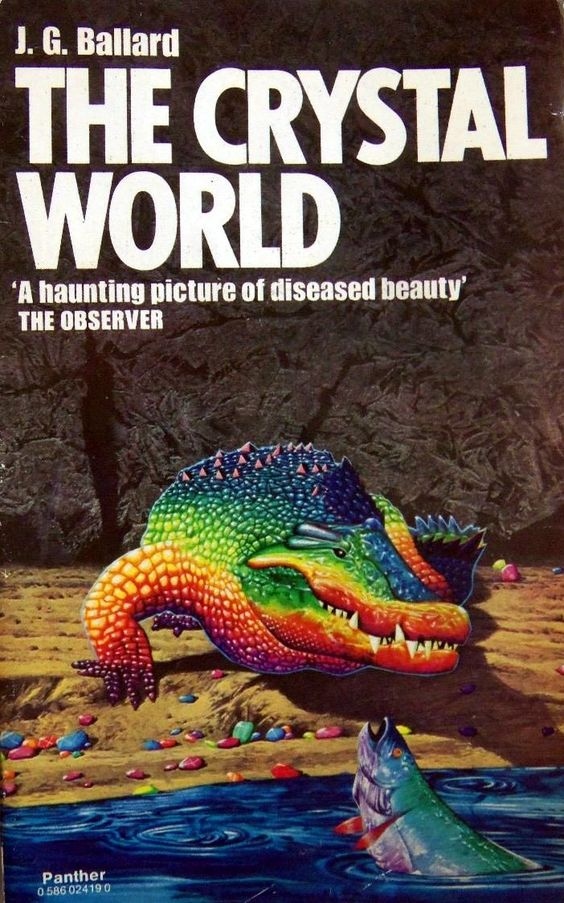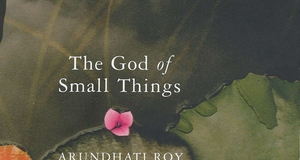Featured Article:Post-Colonial Duality and Identity in Ballard's The Crystal World
By
2016, Vol. 8 No. 11 | pg. 1/1 J. G. Ballard’s The Crystal World (1966) is a prismatic text, apparently translucent yet linguistically opaque, with moments of unexpected ontological intricacy. Like the crystals consuming the forest, Ballard’s descriptive language itself multiplies, encrusting the novel in adjectival embellishment and convoluted pseudo-science. Yet beneath the pop-apocalyptic overtones, The Crystal World is a text deeply informed by its post-colonial setting. In his seminal work Colonial Desire: Hybridity in theory, culture, and race, post-colonial theorist Robert J.C. Young identifies the “simultaneous processes of unification and differentiation” as a defining quality of capitalist development and globalization in the colonial and post-colonial periods (4). Like protagonist Dr. Edward Sanders’ own life, the text’s post-colonial setting is predicated upon an at-times contradictory set of dualities: unification and differentiation, light and dark, life and death. While Sanders is initially seduced by the crystalline forest’s exoticized unfamiliarity and ability to sate his colonial desire for the transgressive other, his ultimate understanding of the forest as an area of hybridization suggests a way in which the contradictions of a collective post-colonial identity may be resolved through the dissolution of selfhood.
Though Sanders’ desire to unravel the scientific cause behind the crystallization is dulled by the glittering beauty of the crystals themselves, he and others in the forest come to understand the process as inherently entropic. Time, it seems, is leaking out of the universe. In a lengthy letter to the director of his hospital, Sanders describes the effect this continual loss of time has upon matter. He writes, “As more and more time “leaks” away … the original atoms and molecules produc[e] spatial replicas of themselves, substance without mass, in an attempt to increase their foothold upon existence” (Ballard 96). This process of “super-saturation,” Sanders explains, is infinite: one atom may produce endless duplicates of itself, ultimately saturating with matter a universe now devoid of time. While Ballard’s fictionalized account of anti-matter and entropy is far from scientifically rigorous, the association between crystals and infinity is actually well studied. So-called “semi-infinite” crystals, featuring a theoretically infinite number of surface planes, do in fact exist (Wang). While the mathematics behind the physical properties of such crystals is far beyond the comprehension of the average layman (including, presumably, Ballard himself), the concept of the infinite form of the crystal multiplying infinitely is nonetheless awe-inspiring in scope. The inverse relationship Ballard establishes between time and matter means that entropy here represents at once death (the end of time) and infinity (the endless proliferation of crystalline matter). Ballard’s writing drips with the very excess it describes. As time leaks away, the crystal matter begins to exist in some way outside of time. If there is no time left in the universe, what possibilities remain for human existence? According to The Crystal World, a space between living and dead opens up for humans to inhabit. What Sanders first refers to as “half-animate immolation within the crystal vaults” many characters understand as a form of immortality (132). For Sanders’ skeptical friend Max, life after crystallization amounts to nothing more than a “kind of instant mummification” (163). For Sanders’ would-be lover Suzanne, who ultimately leads a dancing colony of fellow lepers deep into the crystallization zone, it is something “far more splendid” (163). While none of the characters seem sure of what exactly happens to someone preserved within the crystal, and Ballard’s pseudo-science fails to convincingly explain the phenomenon either, the fact remains that this oddly suspended state of being presents an irresistible alternative for many characters to death, illness, and, in some cases, even life itself. In one poignant yet undeniably eerie scene, Sanders realizes that all around him in the forest are “the half-crystallized bodies of men and women fused against the trunks of the trees, looking up at the refracted sun” (196). Many of these bodies belong to “elderly couples seated together with their bodies fusing into one another” (196). The crystal forest then becomes a living graveyard of sorts, full of bodies in an ambiguously suspended level of consciousness. For Sanders, however, the crystallized forest is seductive for more than just its promise of a form of immortality, though his exact motivations are initially hidden, even from his own mind. The language Ballard uses to illustrate Sanders’ first entry into the forest is revealing. Despite Sanders’ assertion that the crystallized landscape of Mont Royal is redolent of his own childhood (Ballard 77), the scenery is shrouded in opaque layers of language that work to emphasize Sanders’ position as outsider. When Sanders first enters the crystallized forest, it is as though he has “entered an enchanted world” (Ballard 84). Ballard’s writing itself drips with the very excess it describes. Houses are transformed into glistening “wedding cakes,” and an abandoned bicycle becomes “a Fabergé gem, the wheels starred into brilliant jasper crowns” (Ballard 84). Yet this dense language is interrupted by the decidedly unpoetic language of measurement, revealing an obsessive need to quantify and rationalize the scene. We learn that “[t]he process of crystallization [is] more advanced” the deeper into the forest Sanders ventures, with crystals “at least six inches thick” on the fences and “five or six inches high” along the surface of the road (Ballard 85). Exoticized language, however, functions as the primary tool by which the forest’s unreal beauty is explained. Ballard uses terms like “exotic minarets” and “jeweled mandalas” to illustrate the scene (84, 85), transplanting Orientalized imagery from one post-colonial realm to another. Not only is the crystallized forest a doubly unfamiliar space (a post-colonial African port touched by a new and apparently apocalyptic phenomenon), it is also described through the lenses of Indian and Islamic art and architecture, realms which are often conceptualized of as “Oriental” and necessarily external to the European self. This language suggests that for all Sanders’ obsession with the forest (leading up to his eventual decision to forever inhabit the crystallized realm), he is inherently the “other” to its mystifying existence—and therein, perhaps, lays the forest’s ultimate power over him. Young writes that the English identity is fundamentally uncertain, plagued by “its sense of being estranged from itself, sick with desire for the other” (2). For all his philosophical certitude, Sanders himself fits this description remarkably well: deeply estranged from a stable sense of self, he is endlessly seduced by the darkness he considers his opposite, whether that “darkness” is leprosy, shadowy Suzanne, or the struggling priest Balthus. He tells Louise, Suzanne’s “light twin,” “Of course there’s a dark side of the psyche, and I suppose all one can do is find the other face and try to reconcile the two” (Ballard 161). For Sanders, the location of his “dark side” is clear: it is somewhere in the crystallized area. This fascination with the supposed “dark other” is symptomatic of what Young terms “colonial desire”; that is, “a covert but insistent obsession with transgressive, inter-racial sex, hybridity, and miscegenation” (Young ix). While Sanders’ sexual proclivities are beyond the scope of this paper, his obsession with the forest stems explicitly from his belief that it represents a hybrid zone between light and dark. After his first experience in the forest, Sanders waxes philosophical on what the crystals have to teach us about light and dark. In a characteristically grandiose monologue, he lectures Louise:
Though Sanders’ pseudo-philosophy rivals only Ballard’s pseudo-science in its untenability, his conception of the forest as an amalgam of light and dark realized through crystalline rainbows reveals an unrealized model for a more functional post-colonial world. The precarious light-dark duality upon which Sanders’ own life is predicated upon is emblematic of the very dualities that underpin post-colonial life. As Young argues in Colonial Desire, these dualities are quite often contradictory. The white-black or European-native duality, for example, “ostensibly seeks to keep races forever apart, [but] transmutes into expressions of the clandestine, furtive forms of what can be called colonial desire,” leading to a hybridity of race that is unacknowledged yet universally known (Young ix). Colonialism itself creates a set of paradoxical dualities that the post-colonial world must grapple with: simultaneous economic integration and cultural disintegration. Furthermore, colonialism itself creates a set of paradoxical dualities that the post-colonial world must grapple with: simultaneous economic integration and cultural disintegration. In other words, as the world becomes practically “smaller” and more blended, it grows more divided and differentiated along both class and cultural lines. This paradox mirrors the paradox of Ballard’s entropy, wherein the leakage of time from the universe co-occurs with a kind of immortality or elongated temporality via material stasis. Given this near-failure of dualities to function both in Ballard’s constructed world and in the post-colonial world Young describes, as well as the complex role Sanders understands dualities as playing in his own life, it is unsurprising that Sanders is attracted to the “rainbow” world of the crystal forest, where light and dark finally merge. The more time Sanders spends in the forest, he more grows fixated on what the process of hybridization via crystallization means for identity—both his own identity and the identity of the post-colonial collective. While he first hopes to find the dark side of his psyche in the forest, thereby integrating the two halves of his own identity, he ultimately comes to view embalmment in the crystal world as a radical dissolution of the self. Indeed, he writes to the director of his hospital that “the gift of immortality” provided by the forest is “a direct consequence of the surrender by each of us of our own physical and temporal identities” (202). If the self is a set of contradictions between light and dark, the only possible resolution that Sanders sees is the renunciation of personal identity entirely—including, presumably, national, racial, and cultural identity, Sanders continues, “However apostate we may be in this world, there [in the forest] perforce we become apostles of the prismatic sun” (202). The surrender of personal identity seems then to result not only in “immortality,” but also in the acceptance of a larger identity as a collective being that answers only to the “prismatic” sun. With no nations and no churches, the only ruler Sanders envisions is light itself—light that has itself been transformed into something crystalline and eternal even as time leaks away for good. ReferencesBallard, J.G. The Crystal World. New York: Farrar, Strauss & Giroux, 1966. Wang, Huiping, Tingting Gao and Ruibao Tao. “The study of surface states in a semi-infinite crystal.” Scientific Reports 5 (2015). Online. Young, Robert J. C. Colonial Desire: Hybridity in theory, culture, and race. London: Routledge, 1995. Suggested Reading from Inquiries Journal
Inquiries Journal provides undergraduate and graduate students around the world a platform for the wide dissemination of academic work over a range of core disciplines. Representing the work of students from hundreds of institutions around the globe, Inquiries Journal's large database of academic articles is completely free. Learn more | Blog | Submit Latest in Literature |



















